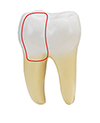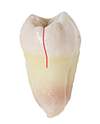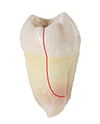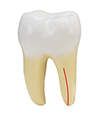


A root canal is one of the most common dental procedures performed, well over 14 million every year. This simple treatment can save your natural teeth and prevent the need of dental implants or bridges.
At the center of your tooth is pulp. Pulp is a collection of blood vessels that helps to build the surrounding tooth. Infection of the pulp can be caused by trauma to the tooth, deep decay, cracks and chips, or repeated dental procedures. Symptoms of the infection can be identified as visible injury or swelling of the tooth, sensitivity to temperature or pain in the tooth and gums.
If you experience any of these symptoms, your dentist will most likely recommend non-surgical treatment to eliminate the diseased pulp. This injured pulp is removed and the root canal system is thoroughly cleaned and sealed. This therapy usually involves local anesthesia and may be completed in one or more visits depending on the treatment required. Success for this type of treatment occurs in about 90% of cases. If your tooth is not amenable to endodontic treatment or the chance of success is unfavorable, you will be informed at the time of consultation or when a complication becomes evident during or after treatment. We use local anesthesia to eliminate discomfort. In addition, we will provide nitrous oxide analgesia if indicated. You will be able to drive home after your treatment, and you probably will be comfortable returning to your normal routine.
The cost associated with this procedure can vary depending on factors such as the severity of damage to the affected tooth and which tooth is affected. In general, endodontic treatment is much less expensive than tooth removal and replacement with an artificial tooth.
In some cases, a tooth that has had a root canal, which did not sufficiently heal or has become re-infected, is not a candidate for endodontic retreatment. For these teeth a minor surgical procedure that treats the infection from the root-end of the tooth, which is known as an apicoectomy, may be indicated. An apicoectomy is an excellent next step procedure to preserve a previously treated tooth, eliminate a dental infection, and to restore the health of the surrounding tissues. It is most useful in cases where fractures or hidden canals still cause pain or infection around a treated tooth, as well as when an endodontic retreatment procedure is not recommended because it may further weaken and jeopardize the tooth.
An apicoectomy may be performed under local anesthesia. It is typically a straightforward procedure during which an incision is made in the gum tissue above the root of the involved tooth. This is to expose the inflamed or infected tissue surrounding the root tip of the tooth. Once uncovered, the damaged tissue in the area is removed along with a few millimeters of the tooth’s root tip. A biocompatible filling material is then placed in the end of the remaining portion of the root to seal it and prevent any possibility of reinfection. The gum tissue flap is put back into place and sutured to complete the procedure.
Post-surgical discomfort is generally mild, and you may have some swelling in the area. Most patients return to their normal activities very quickly. If needed, apply a cold compress to reduce discomfort and swelling after the procedure. The appropriate pain medication will be prescribed or recommended. If your discomfort does not respond to medication, or other symptoms that concern you develop, please call our office.
Prior to undergoing an apicoectomy the dentist will discuss all the risks and benefits of the procedure. If during the course of an apicoectomy, any significant fractures are discovered in the tooth that changes the prognosis, you will be immediately advised.
Although the discomfort of the symptoms is very real, a cracked tooth can be a difficult dental problem to diagnose and pinpoint its location. Even a crack that is microscopic can cause number of symptoms including pain when biting or chewing, sensitivity to hot or cold, or significant discomfort as biting pressure is released.
Chewing on a cracked tooth can be particularly uncomfortable. This is because pieces of the tooth may move and irritate the dental pulp. Eventually this repeated irritation can cause permanent damage to the pulp. The tooth may then consistently hurt and pulpal involvement may worsen. Continued irritation coupled with bacterial contamination seeping in through the crack can lead to a dental infection which can spread from the tooth to the surrounding bone and soft tissues.
Treatment of a cracked tooth depends on the extent of the crack and the degree of pulpal involvement. Symptomatic cases that receive root canal treatment and crowns before the crack propagates too far have a favorable prognosis. Teeth that are considered restorable are those where the crack is confined to the crown portion of the tooth. Complete vertical root fractures have a poor prognosis.
Craze Lines
Craze lines are shallow cracks that only affect the outer enamel of your teeth. They are common in adults and are most often merely regarded as a cosmetic imperfection.
Fractured Cusp
Cusps are pointed or rounded eminences on the chewing surfaces of your teeth. When a cusp for whatever reason (habits, trauma, decay) becomes weakened it can fracture. Chewing with a fractured cusp can cause the movement of the cracked portions of the tooth producing discomfort. At some point the broken portion of the tooth may break off itself or is removed by the dentist. If the fracture did not extend deep into the tooth and cause pulpal involvement, a root canal therapy may not be required. In this case a dental crown or onlay may be sufficient to restore the tooth.
Cracked Tooth
When a crack extends vertically from the chewing surface toward the root, it is referred to as a cracked tooth. In some cases the crack may extend below the gum line into the root. Although a cracked tooth is not completely separated into two pieces damage to the nerve is common. Typically, a root canal treatment is needed to treat the involved pulp in a cracked tooth. Following the root canal the treatment of choice to splint the two halves of the tooth together and prevent further migration of the crack is a full coverage crown.
Although, it is sometimes difficult to determine the extent of the crack, especially when it occurs under a filling or crown, early diagnosis is important. A cracked tooth that is not treated will progressively worsen and may reach the Split Tooth stage that resulting an unfavorable prognosis for the tooth.
Split Tooth
Left untreated a cracked tooth can worsen with the crack extending down the root surface. In a split tooth the crack completely divides the tooth into two distinct segments. The position and extent of the crack determines whether any portion of the tooth can in fact be saved. Only if sufficient tooth structure remains, it might be possible with the help of a root canal to preserve the tooth.
Vertical Root Fracture
A vertical root fracture is a crack that begins in the root of the tooth and extends toward the chewing surface of the tooth. Since they may not manifest overt signs or symptoms, they can go unnoticed for some time. A vertical root fracture is often discovered only when the surrounding area becomes tender or infected. Most frequently, a tooth with a vertical root fracture will require extraction. However, in some situations the tooth may be saved with an endodontic procedure and surgically removing the fractured portion of the root.
Give us a call today and we will be more than happy to answer any questions you might have. Our staff of professionals are dedicated to assisting in any way they can.
Request an Appointment


